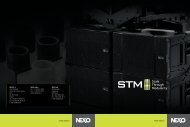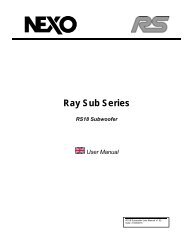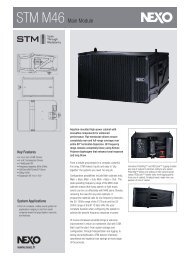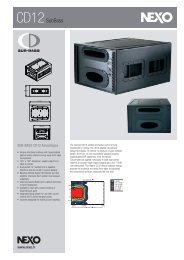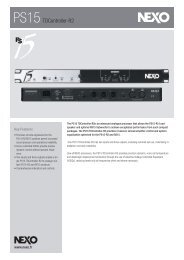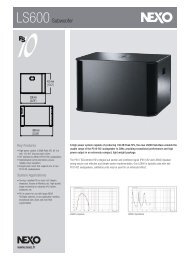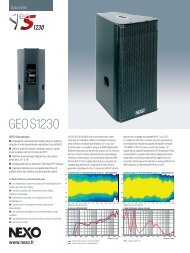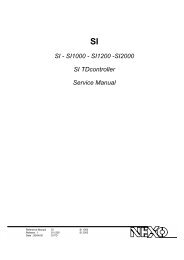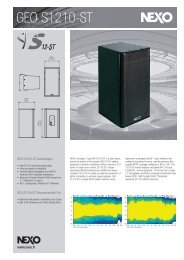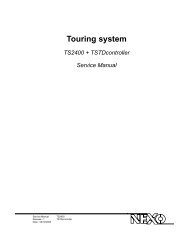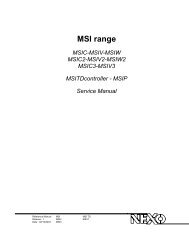NXAMP4x1 & NXAMP4x4 User Manual - Nexo
NXAMP4x1 & NXAMP4x4 User Manual - Nexo
NXAMP4x1 & NXAMP4x4 User Manual - Nexo
- No tags were found...
You also want an ePaper? Increase the reach of your titles
YUMPU automatically turns print PDFs into web optimized ePapers that Google loves.
BLOCK DIAGRAM DESCRIPTIONThe high pass filters are also extremely important as they optimise excursion at very lowfrequency which is a very important safety factor. (Therefore do not use set-ups which arenot designed for the cabinet you are using).Equalising wideband acoustical response (3)This wideband equaliser section achieves the correction required to obtain a flat systemresponse, as the cabinets are acoustically designed for maximum efficiency on the wholefrequency range. Active rather than passive attenuation allows the lowering of amplifiervoltages for a given output SPL and therefore increases the maximum SPL achievable withthe same amplifier. Active equalisation also extends system band pass especially at lowfrequencies where acoustical performance is limited by cabinet size.<strong>User</strong> set-up, Array EQ (4)For each channel, an Array EQ is currently implemented in the NXAMP. The cut offfrequency of a low-shelving filter is factory tuned for each cabinet set-up. The user hasaccess to the gain of this filter. The array EQ is tuned in order to reproduce the effect of thebass coupling, allowing the user to increase or diminish the effect of the stacking (seefurther about the Array EQ menu, or Array EQ setting from ESmonitor).Equalising single component response and NXSTREAM processing (5)This equaliser set allows acting on a specific driver after the crossover, rather than on thewideband section. This allows to EQ one driver without affecting the others (cleaning out ofband response, fine tuning in a crossover…). All the parameters are factory set.Last generation of NXSTREAM algorithm are also implemented in this section. This processuses sophisticated DSP program to go beyond the limits of the conventional EQ filtering, tomanipulate for example the phase of the audio signal independently of the amplitude andso on.Crossover section (6)Crossover between different bands is tuned for every set-up of every cabinet. Eachcrossover is customized so that each transducer will fit with its neighbor by achieving aperfect phase alignment. Unconventional, crossover-defined filters are applied, rangingfrom 6dB/octave to near infinite slopes according to the type of crossover desired. Timealignment is also unconventionally achieved, by combining crossover filter group delayswith all-pass and/or frequency dependent delays.Post protection EQ and low pass (27) (28)After the Protection block (using VCEQ and VCAs, see bellow), another set of EQ / low passfiltering is applied to remove some artefacts due to protection algorithm on some speakersetups.Gain section (29)In this section the digital gain is applied to the corresponding channel. This digital gain iscomputed by the CPU and depends on the user gain, the setup gain for the channel, andthe optimization of the gain ranging done by the CPU.PAGE 34 OF 103



